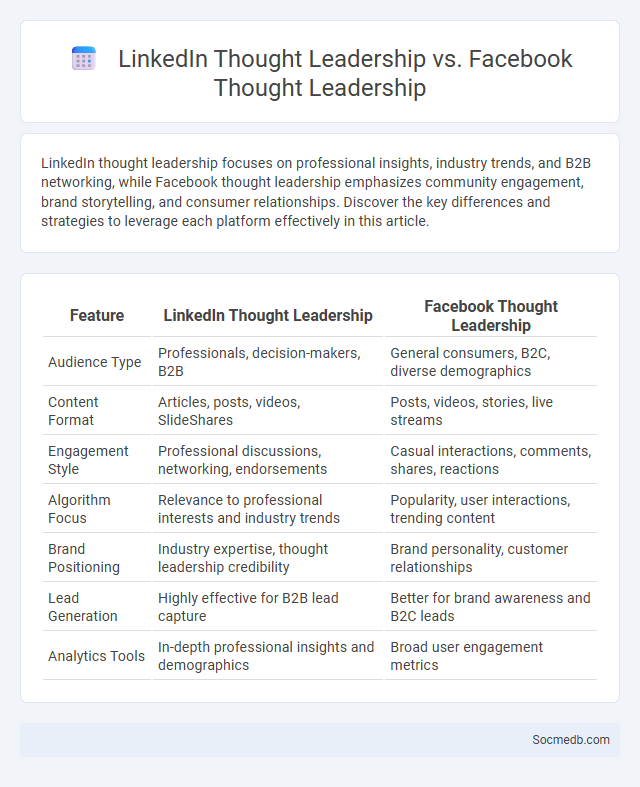
Photo illustration: LinkedIn Thought Leadership vs Facebook Thought Leadership
LinkedIn thought leadership focuses on professional insights, industry trends, and B2B networking, while Facebook thought leadership emphasizes community engagement, brand storytelling, and consumer relationships. Discover the key differences and strategies to leverage each platform effectively in this article.
Table of Comparison
| Feature | LinkedIn Thought Leadership | Facebook Thought Leadership |
|---|---|---|
| Audience Type | Professionals, decision-makers, B2B | General consumers, B2C, diverse demographics |
| Content Format | Articles, posts, videos, SlideShares | Posts, videos, stories, live streams |
| Engagement Style | Professional discussions, networking, endorsements | Casual interactions, comments, shares, reactions |
| Algorithm Focus | Relevance to professional interests and industry trends | Popularity, user interactions, trending content |
| Brand Positioning | Industry expertise, thought leadership credibility | Brand personality, customer relationships |
| Lead Generation | Highly effective for B2B lead capture | Better for brand awareness and B2C leads |
| Analytics Tools | In-depth professional insights and demographics | Broad user engagement metrics |
Understanding Thought Leadership: A Definition
Thought leadership defines Your authority and expertise within a specific industry by consistently providing innovative ideas, insights, and solutions that influence others. Establishing thought leadership on social media involves sharing valuable content, engaging with your audience thoughtfully, and building a reputation as a trusted resource. This strategic approach enhances Your brand visibility, fosters trust, and drives meaningful connections with followers.
Key Features of LinkedIn Thought Leadership
LinkedIn Thought Leadership leverages professional content publishing, targeted networking, and industry-specific groups to establish authority and foster trust among peers. Key features include long-form article posting, personalized content sharing, and robust analytics for measuring engagement and audience growth. Enhanced by algorithm-driven content distribution, these tools amplify visibility and position professionals as influential voices within their sectors.
Unique Advantages of Facebook Thought Leadership
Facebook offers unparalleled opportunities for thought leadership through its vast user base of over 2.9 billion monthly active users, enabling thought leaders to reach and engage diverse audiences worldwide. Its advanced targeting algorithms and detailed analytics provide deep insights into audience behavior, maximizing content impact and fostering meaningful community interactions. The platform's integration of multimedia features, such as live video, Stories, and Groups, further enhances the ability to share authoritative knowledge and stimulate dynamic discussions around industry trends.
Audience Engagement: LinkedIn vs Facebook
LinkedIn drives higher audience engagement through professional content that targets industry-specific groups, fostering meaningful networking and B2B interactions. Facebook's algorithm prioritizes casual, multimedia-rich posts, encouraging interactive features such as comments, shares, and reactions for broader consumer engagement. Brands achieve optimal results by tailoring content to LinkedIn's career-oriented audience while leveraging Facebook's diverse user base for mass reach and community building.
Content Strategies for Each Platform
Effective content strategies for social media platforms require tailoring posts to the unique features and audiences of each channel. On Instagram, prioritize visually engaging photos and short videos with relevant hashtags to boost discoverability, while LinkedIn favors professional insights, articles, and industry-related updates to establish authority. You should leverage Twitter by sharing timely news, concise opinions, and interactive polls to encourage engagement and real-time conversations.
Measuring Impact: LinkedIn vs Facebook
Measuring social media impact on LinkedIn versus Facebook involves analyzing key metrics such as engagement rate, click-through rate, and conversion rate specific to each platform's audience. LinkedIn metrics often emphasize professional interactions, including connection growth, job post engagement, and B2B lead generation, while Facebook metrics prioritize likes, shares, comments, and broader consumer reach. Tools like LinkedIn Analytics and Facebook Insights provide detailed reports that help marketers tailor strategies by comparing performance indicators such as post impressions, audience demographics, and user activity patterns.
Industry Suitability: Where Thought Leadership Thrives
Social media platforms excel in industries driven by innovation, technology, and professional services where thought leadership establishes credibility and thought influence. Sectors like finance, healthcare, and marketing leverage social media to disseminate expert insights, foster community engagement, and build brand authority. Targeted content on LinkedIn, Twitter, and niche forums enhances visibility for professionals aiming to shape industry trends and drive strategic conversations.
Building Authority: Platform-Specific Best Practices
Building authority on social media requires tailoring content and engagement strategies to each platform's unique algorithms and user behaviors. On LinkedIn, sharing industry insights and participating in professional groups establishes credibility, while Instagram's visual storytelling demands consistent, high-quality imagery and interactive features like Stories and Reels. Twitter's emphasis on real-time updates and hashtag usage enables thought leaders to engage with trending conversations and grow their follower base effectively.
Cross-Platform Thought Leadership Integration
Cross-platform thought leadership integration enhances brand visibility by leveraging diverse social media channels like LinkedIn, Twitter, and Instagram to disseminate expert insights consistently. This strategy boosts audience engagement through tailored content that resonates with platform-specific user behaviors and preferences. Data-driven analytics optimize messaging alignment, ensuring cohesive brand authority and increased influence across digital ecosystems.
Choosing the Right Platform for Your Thought Leadership Goals
Identifying the ideal social media platform for thought leadership hinges on understanding audience demographics, content format, and engagement potential. LinkedIn excels in professional networking and industry-specific insights, while Twitter supports real-time discussions and trending topics. Analyzing platform analytics and competitor presence enables strategic content distribution tailored to maximize influence and credibility.
 socmedb.com
socmedb.com